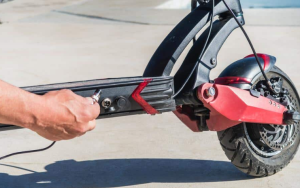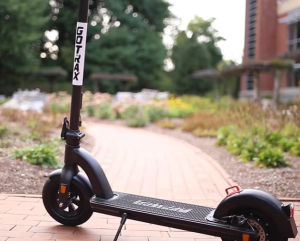Electric scooter cut-outs during acceleration often result from battery issues, loose connections, or motor/controller malfunctions needing thorough inspection and repair.
Understanding the Electrical System of Electric Scooters
Electric scooters rely on a complex electrical system to function efficiently. This system includes several key components, each playing a critical role in the operation and performance of the scooter.

Basic Components and Their Functions
Battery: The battery serves as the power source for electric scooters. Typically, lithium-ion batteries are used due to their high energy density and longevity. They provide the necessary power to run the motor and other electrical components. The capacity of these batteries often dictates the scooter’s range and speed.
Motor: The motor is the heart of the electric scooter, responsible for converting electrical energy into mechanical energy. This conversion propels the scooter forward. Motors in electric scooters vary in power, usually measured in watts, directly influencing the scooter’s top speed and torque.
Controller: Acting as the brain of the electrical system, the controller regulates the power flow from the battery to the motor. It adjusts the current based on the rider’s throttle input, ensuring smooth acceleration and efficient power consumption.
Throttle: The throttle controls the speed of the scooter. By adjusting the throttle, riders can increase or decrease the electrical signal sent to the controller, subsequently controlling the motor’s speed.
How Acceleration Affects Electrical Systems
Acceleration in electric scooters is a crucial aspect that heavily depends on the electrical system. When a rider accelerates, the throttle sends a signal to the controller to increase power delivery from the battery to the motor. This process requires efficient energy transfer and responsive components.
Impact on Battery: Rapid acceleration can lead to a significant drain on the battery. It demands high current flow, which can reduce the battery’s overall lifespan if frequently subjected to such stress.
Motor Response: The motor’s response to acceleration is vital for a smooth ride. Motors with higher wattage can handle acceleration demands better, offering quicker response and more power, but this often comes at the cost of increased battery consumption.
Controller Efficiency: A high-quality controller efficiently manages the power demand during acceleration. It ensures that the motor receives the right amount of power without overloading the battery, maintaining a balance between speed and energy efficiency.
Maintenance Tips to Prevent Power Cut-Outs
Proper maintenance is essential to prevent power cut-outs in electric scooters. Consistent care and regular checks of the scooter’s electrical system can significantly enhance its reliability and longevity.
Regular Inspection and Care of Electrical Components
Inspecting Battery Connections: Ensure the battery connections are secure and free from corrosion. Loose or corroded connections can lead to power interruptions. Use a multimeter to check the battery voltage regularly, ensuring it matches the specifications.
Motor Maintenance: Keep the motor clean and free from debris. A build-up of dirt can lead to overheating and reduced efficiency. For brushless motors, periodic inspection for wear and tear is vital.
Checking the Controller: Examine the controller for any signs of damage like burnt components or loose wiring. A damaged controller can result in inconsistent power distribution.
Best Practices for Battery Management
Regular Charging: Follow the manufacturer’s guidelines for charging. Overcharging or deeply discharging the battery can degrade its quality over time, affecting performance and lifespan.
Temperature Considerations: Store and charge the battery in a temperature-controlled environment. Extreme temperatures, either hot or cold, can adversely affect the battery’s capacity and health.
Balanced Usage: Avoid consistently pushing the scooter to its limits, like continuous high-speed travel or uphill climbs. Balanced usage helps in maintaining the battery’s efficacy and reduces the risk of power cut-outs.
Diagnosing Acceleration Problems in Electric Scooters
Identifying the root cause of acceleration problems in electric scooters requires a systematic approach. Understanding the electrical system and using the right tools and techniques are crucial for an effective diagnosis.
Step-by-Step Guide to Identify Electrical Failures
- Initial Inspection:
- Check for visible signs of damage or wear on the scooter.
- Ensure all connections, especially those leading to the battery and motor, are secure and free from corrosion.
- Battery Testing:
- Use a multimeter to measure the battery voltage. Ensure it aligns with the specifications listed in the scooter’s manual.
- Perform a load test to assess the battery’s ability to hold charge under stress.
- Motor Examination:
- Listen for unusual noises coming from the motor during operation, which can indicate internal issues.
- Inspect the motor for overheating signs, which often point to electrical failures.
- Controller Check:
- Examine the controller for any signs of damage, like burn marks or melted components.
- Test the controller’s output using a multimeter to ensure it properly regulates power.
Tools and Techniques for Effective Diagnosis
- Multimeter: Essential for measuring voltage, current, and resistance in the scooter’s electrical components.
- Load Tester: Useful for assessing the battery’s health and its ability to perform under stress.
- Inspection Tools: Includes flashlights and magnifying glasses to inspect hard-to-see areas for damage or wear.
Identifying Common Issues
- Battery Problems: If the battery fails to meet its specified voltage or performs poorly in load tests, it may need replacement.
- Motor Malfunctions: Abnormal noises or excessive heat from the motor can indicate internal damage requiring professional attention.
- Controller Failures: Irregular power output from the controller often leads to acceleration issues and might necessitate repair or replacement.
Solving Power Cut-Out Issues During Acceleration
Addressing power cut-out issues during acceleration in electric scooters involves identifying and repairing common electrical faults and knowing when to seek professional help. Accurate diagnosis and timely repairs can significantly enhance the scooter’s performance and safety.
Repairing Common Electrical Faults
- Battery Issues:
- Symptoms: Scooter powers off during acceleration, limited range, takes longer to charge.
- Solution: Replace the battery if it fails to hold charge or shows significantly reduced performance. Battery replacement costs vary, but a standard lithium-ion battery can range from $100 to $300 depending on capacity and quality.
- Maintenance Tip: Regularly clean battery terminals and ensure tight connections to prevent power issues.
- Motor Problems:
- Symptoms: Unusual noises, reduced acceleration, overheating.
- Solution: Check for loose connections or damaged wires leading to the motor. In cases of internal motor damage, professional repair or replacement might be necessary, which can cost between $150 and $400 depending on the motor’s power and quality.
- Controller Failures:
- Symptoms: Inconsistent acceleration, scooter behaves erratically.
- Solution: Inspect the controller for any visible damage or burnt components. Controller replacement typically ranges from $50 to $200, depending on the scooter’s specifications.
When to Seek Professional Help
- Complex Electrical Issues: If the problem persists after basic troubleshooting or involves complex components like the motor controller.
- Safety Concerns: When dealing with electrical components, safety is paramount. If you are unsure about any repair process, it’s safer to consult a professional.
- Warranty Considerations: Check if your scooter is still under warranty. Unauthorized repairs might void the warranty, so it’s advisable to seek authorized service centers for repairs.
Resolving Acceleration-Related Power Issues
Successfully resolving acceleration-related power issues in electric scooters often involves learning from real-world examples and adhering to established best practices. These insights can guide scooter owners and technicians in diagnosing and fixing problems more effectively.
Real-World Examples of Troubleshooting
- Case Study 1: Battery Connection Issues
- Problem: A scooter experienced power cut-outs during acceleration.
- Diagnosis: Loose battery connections were causing intermittent power supply.
- Solution: Tightening the connections resolved the issue. The repair cost was minimal, primarily requiring labor.
- Lesson: Regularly check and secure all electrical connections to prevent similar issues.
- Case Study 2: Overheated Motor
- Problem: Scooter’s acceleration was sluggish, and the motor felt unusually hot.
- Diagnosis: The motor was overheating due to blocked air vents and excessive load.
- Solution: Cleaning the vents and advising the user on load limitations fixed the problem. The cost was again minimal but crucial for maintaining the motor’s lifespan.
- Lesson: Ensure proper ventilation for the motor and avoid overloading the scooter.
Lessons Learned and Best Practices
- Regular Maintenance: Regularly inspect and maintain the scooter’s electrical components, including the battery, motor, and controller.
- Understand Limitations: Know the performance limits of your scooter, including its maximum load capacity and optimal operating conditions.
- Quality Parts: Use high-quality replacement parts, especially for critical components like batteries and motors. While the initial cost may be higher, quality parts ensure better performance and longevity.
- Professional Advice: When in doubt, seek advice from professionals. They can provide insights based on experience and expertise.
- Safety First: Always prioritize safety when performing repairs or maintenance. This includes using the correct tools and following proper electrical safety procedures.


